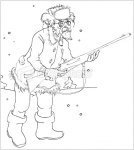The US standard railroad gauge (distance between the rails) is 4 feet, 8.5 inches. That's an exceedingly odd number.
Why was that gauge used?
Well, because that's the way they built them in England, and English engineers designed the first US railroads.
Why did the English build them like that?
Because the first rail lines were built by the same people who built the wagon tramways, and that's the gauge they used.
So, why did 'they' use that gauge then?
Because the people who built the tramways used the same jigs and tools that they had used for building wagons, which used that same wheel spacing.
Why did the wagons have that particular odd wheel spacing?
Well, if they tried to use any other spacing, the wagon wheels would break more often on some of the old, long distance roads in England . You see, that's the spacing of the wheel ruts.
So who built those old rutted roads?
Imperial Rome built the first long distance roads in Europe (including England ) for their legions. Those roads have been used ever since.
And what about the ruts in the roads?
Roman war chariots formed the initial ruts, which everyone else had to match or run the risk of destroying their wagon wheels. Since the chariots were made for Imperial Rome , they were all alike in the matter of wheel spacing. Therefore the United States standard railroad gauge of 4 feet, 8.5 inches is derived from the original specifications for an Imperial Roman war chariot. Bureaucracies live forever.
So the next time you are handed a specification/procedure/process and wonder 'What horse's ass came up with this?', you may be exactly right. Imperial Roman army chariots were made just wide enough to accommodate the rear ends of two war horses. (Two horses' asses.)
Now, the twist to the story:
When you see a Space Shuttle sitting on its launch pad, there are two big booster rockets attached to the sides of the main fuel tank. These are solid rocket boosters, or SRBs. The SRBs are made by Thiokol at their factory in Utah . The engineers who designed the SRBs would have preferred to make them a bit fatter, but the SRBs had to be shipped by train from the factory to the launch site. The railroad line from the factory happens to run through a tunnel in the mountains, and the SRBs had to fit through that tunnel. The tunnel is slightly wider than the railroad track, and the railroad track, as you now know, is about as wide as two horses' behinds.
So, a major Space Shuttle design feature, of what is arguably the world's most advanced transportation system, was determined over two thousand years ago by the width of a horse's ass. And you thought being a horse's ass wasn't important? Ancient horse's asses control almost everything and....
CURRENT Horses Asses are controlling everything else
Welcome guest, is this your first visit? Create Account now to join.
Welcome to the NZ Hunting and Shooting Forums.
Search Forums
User Tag List
+ Reply to Thread
Results 1 to 15 of 41
Thread: 4 feet 8 1/2 inches
-
07-05-2020, 03:13 PM #1
4 feet 8 1/2 inches
-
-
07-05-2020, 03:34 PM #2Member

- Join Date
- Jun 2015
- Location
- christchurch
- Posts
- 18,531
-
07-05-2020, 05:07 PM #3OPCz


- Join Date
- Jun 2012
- Location
- Nor West of Auckland on the true right of the Kaipara River
- Posts
- 34,659
Very amusing
It takes 43 muscle's to frown and 17 to smile, but only 3 for proper trigger pull.
What more do we need? If we are above ground and breathing the rest is up to us!
Rule 1: Treat every firearm as loaded
Rule 2: Always point firearms in a safe direction
Rule 3: Load a firearm only when ready to fire
Rule 4: Identify your target beyond all doubt
Rule 5: Check your firing zone
Rule 6: Store firearms and ammunition safely
Rule 7: Avoid alcohol and drugs when handling firearms
-
07-05-2020, 05:12 PM #4
I pinched it off another website....far too good not to share.....horses arse makes the decision...sounds vaugely familiar....
-
07-05-2020, 05:13 PM #5
-
07-05-2020, 05:18 PM #6
Romans gave us Miles too, but it's a human, not equine measure.
Mile is from "milli" - a thousand. A thousand paces (one left + one right step) is 1600 metres, 1 mile.
A Roman legionnaire could compel any bystander to carry his equipment for him for one mile, hence the expression of "going a second mile" for someone.An itch ... is ... a desire to scratch
-
07-05-2020, 05:24 PM #7Member

- Join Date
- Jan 2015
- Location
- Waikato
- Posts
- 2,234
The measurement that has always intrigued me is the "firkin"...too firkin fast/slow...too firkin far...and many others.
-
07-05-2020, 05:25 PM #8Member

- Join Date
- May 2018
- Location
- Porirua
- Posts
- 1,342
Have a look at a map of England, all the towns are about 20 miles from each other.
That as far as a horse could walk in a day.Remember the 7 “P”s; Pryor Preparation Prevents Piss Poor Performance.
-
07-05-2020, 05:27 PM #9
-
07-05-2020, 06:01 PM #10
Close-ish. There were a number of gauges used until they standardised , much like here. Unfortunately they settled on a stupidly narrow standard gauge here.
There are only three types of people in this world. Those that can count, and those that can't!
-
07-05-2020, 06:07 PM #11
I have the answer, Sir!. Gospel of Matthew, sermon on the mount by God's son. It was along other sayings like turning the other cheek, if someone robs you of your coat, offer him your shirt too, if you're compelled by someone to go with him one mile, go with him two.
Not sure how it relates to the firearms buyback robbery. If Jacinda steals your rifle, give unto her also your toothbrush?An itch ... is ... a desire to scratch
-
07-05-2020, 06:14 PM #12Member

- Join Date
- Aug 2019
- Location
- South Otago
- Posts
- 3,998
-
07-05-2020, 06:47 PM #13
she wanted your colt ar15 and the ammunition too perhaps..... brownie points duely earned....
-
07-05-2020, 06:59 PM #14
Engineering wise that makes no sense whatsoever. Narrow gauge on tighter turns would lead to instability. The main thing that would determine the tightness of a turn would be the length of the locomotives between fixed axles and the sideways play that is allowed. The wider the gauge the more play that would be allowed.
There are only three types of people in this world. Those that can count, and those that can't!
-
07-05-2020, 07:17 PM #15Member

- Join Date
- Jan 2015
- Location
- Waikato
- Posts
- 2,234
Back in the 70's I worked for an outfit that built a large storage warehouse, between the buildings were two sets of rail lines laid that would hold 50 odd wagons, the rail siding was concreted and the first rail wagon shunted in derailed as the concrete had been laid to the wrong side of the wheel flanges...took a lot of cutting and jack hammering to get it right.
Similar Threads
-
Suppressor changing point of impact by inches
By Russian 22. in forum ShootingReplies: 21Last Post: 23-12-2018, 05:01 PM -
F&*$ You, Inches!
By Dougie in forum ShootingReplies: 28Last Post: 24-11-2014, 04:14 PM -
Labradors feet
By Bob Da Browning in forum Hunting DogsReplies: 14Last Post: 09-06-2014, 06:09 PM -
cutting a 16 inch carbine barrel to 12 inches
By Bill999 in forum Firearms, Optics and AccessoriesReplies: 42Last Post: 31-03-2013, 10:44 PM
Tags for this Thread
Welcome to NZ Hunting and Shooting Forums! We see you're new here, or arn't logged in. Create an account, and Login for full access including our FREE BUY and SELL section Register NOW!!





 62Likes
62Likes LinkBack URL
LinkBack URL About LinkBacks
About LinkBacks



 Reply With Quote
Reply With Quote




Bookmarks